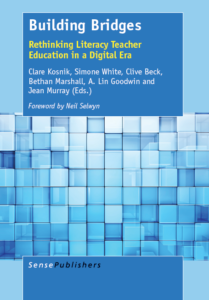 I am pleased to announce the publication of a new book edited by Clare Kosnik, Simone White, Clive Beck, Bethan Marshall, A. Lin Goodwin, and Jean Murray entitled Building bridges: Rethinking literacy teacher education in a digital era.
I am pleased to announce the publication of a new book edited by Clare Kosnik, Simone White, Clive Beck, Bethan Marshall, A. Lin Goodwin, and Jean Murray entitled Building bridges: Rethinking literacy teacher education in a digital era.
This book emerged from presentations made at a working conference in London in 2014. I was honoured to be a part of both the conference and this book. My own chapter provides a conceptual overview of some of the tensions and challenges of the concept of digital technologies in teacher education. It concludes with some ideas from my Maker Pedagogy project.
Sense Publishers always provides a free preview of the first chapter of books that it publishes, and that means anyone can download my chapter for free by clicking here.
My sincere thanks to the editorial team for their hard work and particularly to Clare Kosnik for inviting me to be a part of her research into digital technologies several years ago, even before this project started. You should check out her blog at: https://literacyteaching.net/
Bullock, S. M. (2016). Digital technologies in teacher education: From mythologies to making. In C. Kosnik, S. White, C. Beck, B. Marshall, A. L. Goodwin, & J. Murray (Eds.), Building bridges: Rethinking literacy teacher education in a digital era (pp. 3–16). Rotterdam, The Netherlands: Sense Publishers.
/smb
